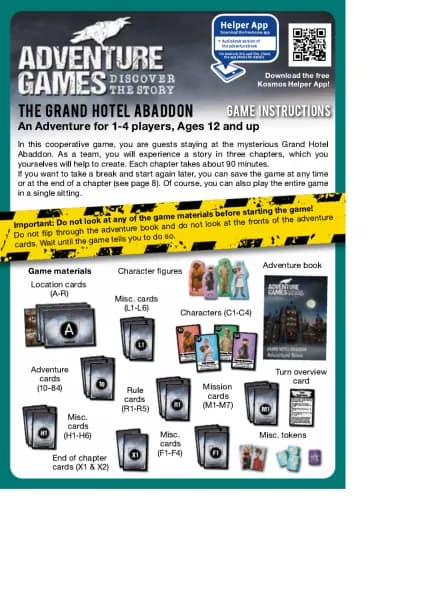Thames & Kosmos Electro Chem Clock handleiding
Handleiding
Je bekijkt pagina 1 van 2

ELECTRO
CHEM
CLOCK
WARNING — Chemistry Set. This set contains
chemicals and parts that may be harmful if misused. Read
cautions on individual containers and in manual carefully.
Not to be used by children except under adult supervision.
Contents
2
EXPERIMENT 1
Starting Up the Lemonade Clock!
Information about Environmental Protection
Safety Notes
Dear Parents! How to Assemble Your Clock
STEP 2
STEP 1
NOTE! Not suitable for children under 3 years of age. There is a danger of choking due to
small parts that may be swallowed or inhaled. Individual parts of this kit have sharp or
pointed edges or corners. Do not injure yourself! Do not drink any of the liquids used for
powering the lemonade clock.
NOTE! Only for use by children 8 years and older. Instructions are included for parents
or other supervising individuals, and they must be followed.
Save the packaging and instructions, as they contain important information.
› Two AA batteries (1.5-volt, type AA / LR6 / penlight) are required. They are not
included in the kit due to their limited storage life.
› Avoid short-circuiting the batteries. A short circuit can cause the wires to overheat
and the batteries to explode.
› Do not mix old and new batteries.
› Do not mix alkaline, standard (carbon-zinc), or rechargeable (nickel-cadmium)
batteries.
› Always insert batteries in the right polarity orientation, pressing them gently into
the battery compartment.
› Do not recharge non-rechargeable batteries. They could explode!
› Rechargeable batteries should only be charged under adult supervision.
› Rechargeable batteries are to be removed from the toy before being charged
› Exhausted batteries must be removed from the toy.
› Dispose of used batteries in accordance with environmental provisions.
› Be sure not to bring batteries into contact with coins, keys, or other metal objects.
› Avoid deforming the batteries.
› The wires are not to be inserted into socket-outlets.
Before beginning the experiments, read through the instruction manual with your
child and discuss the safety notes. Check that the lemonade clock has been properly
assembled before use, and assist your child with the experiments. Have fun with the
experiments!
Guide both digital clock wires through
the holes in the assembly board, as
shown in the illustration.
Position the digital clock on the
sloping section of the assembly board.
YOU WILL NEED:
› Assembly board with digital clock, cup for liquids,
cup lid, 2 copper sheets, 2 zinc sheets,
lemonade or lemon soda
Firmly insert both contact springs
narrow-side-down into the assembly
board. The picture shows the correct
position.
Guide the black wire from the bottom
through the hole next to contact
spring 1. Guide the red wire through
the contact board next to contact
spring 2.
When you bend the contact springs to
the side, it creates gaps in which you
can clamp the ends of the wires.
Clamp the digital clock’s black wire in
contact spring 1 and the red wire in
contact spring 2.
YOU WILL NEED:
› Digital clock, assembly board
with battery compartment, 2
contact springs
1st Edition 2013
© 2013 Franckh-Kosmos Verlags-GmbH & Co. KG,
Pfizerstrasse 5 – 7, 70184 Stuttgart, Germany
This work, including all its parts, is copyright protected.
Any use outside the specific limits of the copyright law is
prohibited and punishable by law without the consent of
the publisher. This applies specifically to reproductions,
translations, microfilming, and storage and processing
in electronic systems, networks, and media. We do not
guarantee that all the information in this work is free
from copyright or other protection.
Project management: Dr. Mark Bachofer, Kristin Albert; Technical
product development: Dr. Petra Müller; Manual design: Atelier Bea
Klenk, Berlin; Basic manual layout: Anke Engelmann, 599media,
Freiberg; Revision and technical editing: Natalie Rapka, reinisch AG,
Karlsruhe; Manual and packaging photos: ilker canikligil (water
drops), atoss (lemon), ApostolPetr (atom, all © shutterstock.com); jufo
(water tap), Markus Mainka (bottles, both © fotolia.com); Alessandro
Volta painting, unknown artist, Wikipedia, public domain; Manual and
packaging illustrations: Phil Porter, reinisch AG, Karlsruhe; Packaging
design and layout: Peter Schmidt Group GmbH, Hamburg
1st English Edition © 2013 Thames & Kosmos, LLC, Providence,
RI, U.S.A.
® Thames & Kosmos is a registered trademark of Thames &
Kosmos, LLC.
Editing: Ted McGuire; Additional Graphics and Layout: Dan
Freitas
Distributed in North America by Thames & Kosmos, LLC.
Providence, RI 02903; Phone: 800-587-2872;
Email: support@thamesandkosmos.com
We reserve the right to make technical changes. Printed in China / Imprimé en Chine
›
Digital clock
›
2 Copper sheets
›
2 Zinc sheets
›
Cup for liquids
›
Cup lid
›
Assembly board with battery
compartment
›
2 Contact springs
You will also need:
› Lemonade or lemon soda
› Paper towels
› Various liquids
› 2 x AA Batteries (1.5-Volt, type
AA / LR6 / Mignon)
1
1. Fill the two chambers of the cup with lemonade
or lemon soda up to about 1 cm beneath the rim.
This will be your battery’s conducting liquid.
2. Put the lid on the cup. Slide one reddish copper
sheet and one silver-colored zinc sheet through
the slits of each chamber.
3. Mount the cup on the assembly board as shown in
the illustration. Clamp the cup’s black wire into
contact spring 1 and the red wire into contact
spring 2.
None of the electrical or electronic components in this kit should be
disposed of in the regular household trash when you have finished using
them; instead, they must be delivered to a collection location for the
recycling of electrical and electronic devices. The symbol on the product,
instructions for use, or packaging will indicate this.
The materials are reusable in accordance with their designation. By reusing or
recycling used devices, you are making an important contribution to the protection
of the environment. Please consult your local authorities for the appropriate
disposal location.
Now your clock will start running! You will see
numbers and blinking double dots appear on
the display.
CAUTION!
Do not let the sheets touch each
other! The pair of sheets connected by the red
wire must not be inserted together into a single
chamber.
WHY As soon as the electrodes are immersed into the liquid, they
release positively-charged metal ions from the sheets due to the action of the
acids in the lemonade, getting back negatively-charged electrons in return.
These electrons are then able to move freely in the metal.
That happens in the copper as well as the zinc, but there’s an important
difference. The copper atoms are very reluctant to accept back any electrons,
while a lot of electrons collect very quickly in the zinc sheet.
Now, if you connect the two sheets, it closes the electrical circuit. The excess
electrons move from the zinc electrode to the copper electrode. Electrical
current flows!
Would you like to know what electrodes, ions, and electrons are? Then take
a look at the “Check It Out” section!
Contact spring 2Contact spring 1
1
2
3
EXPERIMENT MANUAL
Bekijk gratis de handleiding van Thames & Kosmos Electro Chem Clock, stel vragen en lees de antwoorden op veelvoorkomende problemen, of gebruik onze assistent om sneller informatie in de handleiding te vinden of uitleg te krijgen over specifieke functies.
Productinformatie
| Merk | Thames & Kosmos |
| Model | Electro Chem Clock |
| Categorie | Niet gecategoriseerd |
| Taal | Nederlands |
| Grootte | 4296 MB |







